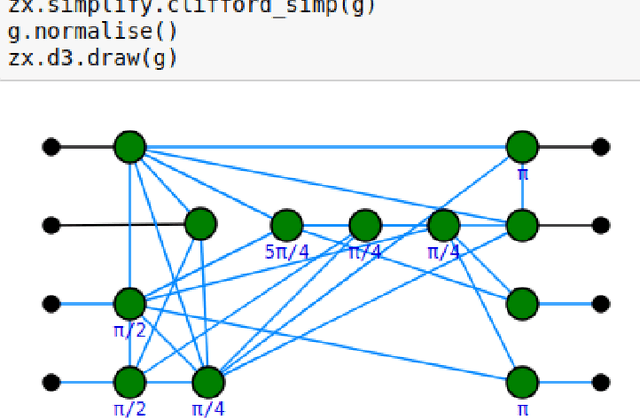Quanlong Wang
Differentiating and Integrating ZX Diagrams
Jan 31, 2022
Abstract:ZX-calculus has proved to be a useful tool for quantum technology with a wide range of successful applications. Most of these applications are of an algebraic nature. However, other tasks that involve differentiation and integration remain unreachable with current ZX techniques. Here we elevate ZX to an analytical perspective by realising differentiation and integration entirely within the framework of ZX-calculus. We explicitly illustrate the new analytic framework of ZX-calculus by applying it in context of quantum machine learning.
Representing Matrices Using Algebraic ZX-calculus
Oct 13, 2021

Abstract:Elementary matrices play an important role in linear algebra applications. In this paper, we represent all the elementary matrices of size 2^m\times 2^m using algebraic ZX-calculus. Then we show their properties on inverses and transpose using rewriting rules of ZX-calculus. As a consequence, we are able to depict any matrices of size 2^m\times 2^n by string diagrams without resort to a diagrammatic normal form for matrices as shown in [Wang 2020]. By doing so we pave the way towards visualising by string diagrams important matrix technologies deployed in AI especially machine learning.
Reasoning about conscious experience with axiomatic and graphical mathematics
Jun 30, 2021
Abstract:We cast aspects of consciousness in axiomatic mathematical terms, using the graphical calculus of general process theories (a.k.a symmetric monoidal categories and Frobenius algebras therein). This calculus exploits the ontological neutrality of process theories. A toy example using the axiomatic calculus is given to show the power of this approach, recovering other aspects of conscious experience, such as external and internal subjective distinction, privacy or unreadability of personal subjective experience, and phenomenal unity, one of the main issues for scientific studies of consciousness. In fact, these features naturally arise from the compositional nature of axiomatic calculus.
Kindergarden quantum mechanics graduates (...or how I learned to stop gluing LEGO together and love the ZX-calculus)
Feb 22, 2021
Abstract:This paper is a `spiritual child' of the 2005 lecture notes Kindergarten Quantum Mechanics, which showed how a simple, pictorial extension of Dirac notation allowed several quantum features to be easily expressed and derived, using language even a kindergartner can understand. Central to that approach was the use of pictures and pictorial transformation rules to understand and derive features of quantum theory and computation. However, this approach left many wondering `where's the beef?' In other words, was this new approach capable of producing new results, or was it simply an aesthetically pleasing way to restate stuff we already know? The aim of this sequel paper is to say `here's the beef!', and highlight some of the major results of the approach advocated in Kindergarten Quantum Mechanics, and how they are being applied to tackle practical problems on real quantum computers. We will focus mainly on what has become the Swiss army knife of the pictorial formalism: the ZX-calculus. First we look at some of the ideas behind the ZX-calculus, comparing and contrasting it with the usual quantum circuit formalism. We then survey results from the past 2 years falling into three categories: (1) completeness of the rules of the ZX-calculus, (2) state-of-the-art quantum circuit optimisation results in commercial and open-source quantum compilers relying on ZX, and (3) the use of ZX in translating real-world stuff like natural language into quantum circuits that can be run on today's (very limited) quantum hardware. We also take the title literally, and outline an ongoing experiment aiming to show that ZX-calculus enables children to do cutting-edge quantum computing stuff. If anything, this would truly confirm that `kindergarten quantum mechanics' wasn't just a joke.
A Compositional Model of Consciousness based on Consciousness-Only
Aug 05, 2020


Abstract:Scientific studies of consciousness rely on objects whose existence is independent of any consciousness. This theoretical-assumption leads to the "hard problem" of consciousness. We avoid this problem by assuming consciousness to be fundamental, and the main feature of consciousness is characterized as being other-dependent. We set up a framework which naturally subsumes the other-dependent feature by defining a compact closed category where morphisms represent conscious processes. These morphisms are a composition of a set of generators, each being specified by their relations with other generators, and therefore other-dependent. The framework is general enough, i.e. parameters in the morphisms take values in arbitrary commutative semi-rings, from which any finitely dimensional system can be dealt with. Our proposal fits well into a compositional model of consciousness and is an important step forward that addresses both the hard problem of consciousness and the combination problem of (proto)-panpsychism.
 Add to Chrome
Add to Chrome Add to Firefox
Add to Firefox Add to Edge
Add to Edge